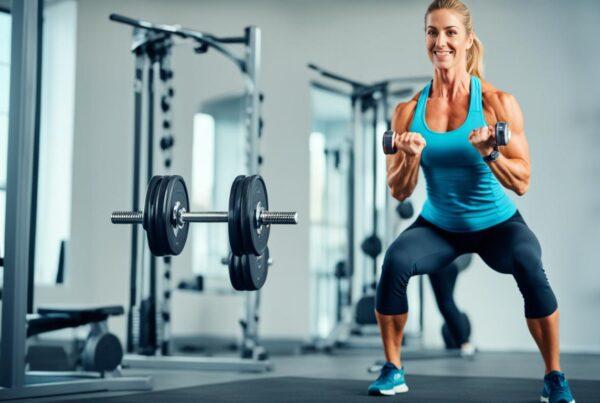When you’re seeking a workout routine that maximizes core strength benefits without complex equipment, look no further than the humble plank. Renowned for its simplicity and efficiency, the plank is a bodyweight exercise that targets a host of muscles to bolster your functional fitness. Whether incorporated into yoga, pilates, or your strength training regimen, planks are the linchpin for enhancing stability and improving posture. From beginner planks to advanced variations, engaging the muscles that planks work can transform the way your body looks and feels answering the age old question of “what muscles do planks work?”.
But planks offer more than just core engagement; they’re a holistic approach to conditioning your body. As you work towards that rock-solid core, you’re also laying a foundation for a resilient, fully functional physique that supports your daily activities and athletic performance. Let’s kickstart your journey to a stronger self with insights into how planks can be a versatile and powerful addition to your fitness arsenal.
Key Takeaways
- Discover what muscles planks target for comprehensive core conditioning.
- Embrace planks for their unmatched core strength benefits and role in functional fitness.
- Learn how to incorporate planks effectively into your workout routine.
- Understand the value of planks in promoting stability and good posture.
- Explore diverse plank variations to suit both beginners and advanced fitness enthusiasts.
- Realize how planks can complement other exercise disciplines like yoga and pilates.
Understanding the Plank: More Than Just an Ab Workout
When you think of planking, you might envision it as a workout aimed solely at sculpting your abdominal muscles. Yet, this isometric exercise serves a grander purpose in your strength training and functional fitness regimen. Let’s delve into the dynamic world of planking and uncover how this seemingly simple pose can revolutionize your core stability and overall muscular synergy.
The Anatomy of a Plank: What Multiple Muscles Do Planks Work?
At a glance, the plank might come off as an exercise targeting primarily your abdominal muscles, primarily the rectus abdominis. However, it also activates the deeper layer known as the transverse abdominis, and let’s not forget the crucial role played by your obliques. Together, these core muscles form an intricate network that supports a multitude of bodily movements—and planking taps into each of these to strengthen your midsection like no other exercise.
The Importance of Bracing for Core Stability and Strength
Why should you care about bracing during your workout routine? Simply put, it’s the cornerstone of core stability. The action of bracing amplifies the engagement of your core muscles, fortifying your midsection, and enabling a more effective transfer of force throughout your body. Whether you’re a seasoned athlete or simply pursuing a healthier lifestyle, incorporating planking into your regimen reinforces core stability that translates into everyday activities.
Isometric Exercise: Why Planks Are a Staple in Fitness Regimens
Isometric exercise, such as the plank, is a celebrated hero in the world of functional fitness due to its simplicity and effectiveness. By maintaining a static position, you invite your body to create tension without movement, which is invaluable for enhancing muscle endurance and strength. This unique trait of planking makes it a staple, benefitting your core muscles while contributing to a solid foundation for other dynamic exercises in your workout routine.
| Muscle Group | Role in Planking | Benefits |
|---|---|---|
| Rectus Abdominis | Primary muscle for spinal flexion | Improved posture, stability |
| Transverse Abdominis | Stabilizes core and spine | Enhanced core endurance, injury prevention |
| Obliques | Assists in rotation and lateral flexion | Greater functional movement, twist mobility |
Ultimately, embracing the humble plank can make a significant impact on your core muscles, thus contributing to increased core stability and aiding in your ongoing quest for functional fitness. With the right technique and a dedication to regular practice, you will unlock the full potential of your strength training journey.
Mastering Proper Plank Form for Optimal Muscle Engagement
Embarking on your fitness journey, you’ve likely heard about the myriad of core strength benefits that come from incorporating planks into your workout routine. To harness the full potential of this exercise, it’s essential to understand and execute proper plank form, which is pivotal not just for muscle engagement but also for achieving peak functional fitness, impeccable posture, and overall stability.
Let’s break down the anatomically precise technique:
- Start by placing your elbows directly under your shoulders, ensuring they are aligned to avoid unnecessary strain.
- Extend your legs back one at a time, coming up onto your toes and engaging your leg muscles.
- Activate your core muscles to uphold a straight line from your heels to your head, preventing your pelvis from either sagging or lifting.
- Keep your neck in a neutral position by fixing your gaze toward the ground, in line with your forearms.
A common mistake is to neglect the upper back, which is essential for maintaining a flat plank. Keep those muscles taut, contributing to the plank’s effectiveness and ensuring your back remains parallel to the floor.
Bear in mind these cues throughout each second to guarantee you are optimizing each plank for maximum core muscle recruitment. Not only does this precision in form elevate your workout efficiency, but it also escalates the core strength benefits, making every moment of your hold count.
Remember, the journey to master perfect plank form is one of practice and patience. Every workout offers the opportunity to refine your technique, bringing you closer to the apex of functional fitness. Embrace each plank as a cornerstone of your routine, and relish the profound benefits that result from your dedicated efforts.
The Comprehensive Impact of Planks on Your Core Muscles
When you engage in the simple yet powerful plank exercise, you’re not just toning your midsection; you’re also activating a complex system of muscles that work in harmony to promote core strength, enhance posture, and ensure stability during everyday tasks and fitness routines. Let’s dissect the pivotal roles of these muscles to better understand the extensive benefits planks provide for your functional fitness.
Rectus Abdominis and Transverse Abdominis: The Frontline of Your Core
The rectus abdominis and the transverse abdominis are your body’s natural corset. These muscles comprise the front line of defense, offering structural support and playing a crucial role in movements such as bending and stabilizing your torso. By regularly practicing planks, you ensure these muscles are well-conditioned, which translates to a stronger, more stable core.
Internal and External Obliques: The Side Supporters
Your internal obliques and external obliques act as steadfast sidekicks in the quest for core fitness. Essential for rotational movements and side-bending, the obliques provide the necessary support needed for complex, multi-directional movements, thus bolstering your lateral stability.
Glutes and Back Muscles: Essential for a Balanced Core
While often overlooked, the glutes and back muscles play pivotal roles in maintaining a balanced core. Planks require the engagement of these posterior muscles, which helps counteract the negative effects of prolonged sitting and improves your overall posture. Strengthening these muscle groups creates a solid foundation for your spine, pivotal for a well-rounded fitness regimen.

What Muscles Do Planks Work: Beyond the Core to Total-Body Fitness
When you incorporate planks into your workout routine, you’re signing up for more than just a solid core; you’re on the path to achieving total-body fitness. This simple yet powerful exercise fortifies various muscle groups, ensuring your pursuit of functional fitness doesn’t stop at just a toned abdomen. Planks are a staple of strength training due to their capacity to enhance posture and provide stability while engaging muscles across your entire body.
Shoulder and Back Muscles: Creating a Robust Upper Body
Shoulder muscles and back muscles gain significant strength from the static hold of a plank position. As you stabilize your torso, the serratus anterior, trapezius, and rhomboids are all called to action, reinforcing the upper back and shoulder girdle. Consequently, this leads to improved shoulder stability and a more imposing upper body physique, vital components of a robust frame.
Leg Muscles: Incorporating Quads, Hamstrings, and Calves
While the core is the star of the show during planks, your leg muscles, including the quads, hamstrings, and calves, are silently working behind the scenes. Engaging these muscles is crucial for maintaining the correct plank posture and contributes to the holistic nature of the exercise, highlighting its role in fostering a full-body workout experience.
Enhanced Posture and Stability Through Consistent Practice
The key to unlocking enhanced posture and stability is consistent practice of planks within your routine. Regular engagement of your core and surrounding muscles helps to distribute weight evenly, align the spine, and prevent injury, paving the way for improved functionality in everyday movements and athletic performance alike.

| Muscle Group | Key Muscles Worked | Benefits |
|---|---|---|
| Core | Rectus Abdominis, Transverse Abdominis, Obliques | Improved posture, increased abdominal strength |
| Upper Body | Anterior Deltoids, Serratus Anterior, Trapezius, Rhomboids | Robust shoulder region, enhanced upper body stability |
| Lower Body | Quadriceps, Hamstrings, Calves | Better alignment, injury prevention, balanced strength development |
Conclusion
As we’ve explored, the humble plank is more than just a staple in your workout routine; it’s a powerful ally in achieving core strength benefits and enhancing your total-body fitness. Through its ability to work a multitude of muscle groups, planking serves as a foundation for functional fitness, improving stability and posture. No matter your current level of fitness – whether you’re a beginner or at an advanced stage – there’s a plank variation that’s right for you.
Incorporating planks into your regular exercise regimen can certainly augment strength training sessions. They are a key bodyweight exercise that can be performed anywhere, and they complement other practices such as yoga and pilates seamlessly. Adhering to proper form ensures that each plank you perform maximizes its potential to fortify your core and stabilize your body.
Embrace planks as a crucial component of your fitness journey. With consistent practice, you’ll notice a marked improvement in your core’s resilience and your body’s overall strength. So, integrate planks into your routines and bear witness to the transformative effects they have on your body from the inside out, propelling you towards a healthier, stronger you.








